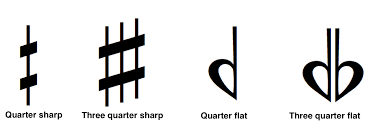Please understand that for all winds, we have to use special fingerings or lip adjustments for microtonal playing. This can make fast passages tricky, and not just twice as tricky, but I would even say to a factor between 5 and 10 times as hard. My first advice is to avoid fast passages, but there are ways under which quick microtonal passages can work, so here are some guidelines:
In short, if you have to go fast:
- avoid notes that need to be lipped, or need to have the flutist roll the flute in or out (i.e. notes that have no fingerings): G-1/4 flat (F-3/4 sharp) and all the notes below our low Eb (anything produced by the foot joint, where there are no open holes), unless all notes in the passage can be lipped in the same direction (all 1/4 or 3/4 sharps, for example).
- if you are considering such a lipped passage, don’t mix 12ET (chromatic) and microtones together. If we have to lip, it’s nice if we can keep our lips in the same direction for an ergonomic length of time and not have to “reset” to normal for a single note in a fast passage.
- whether lipped or fingered, keep the motion scalar, larger intervals can be trickier esp. over a break
- keep the passage short or discontinuous
These remarks are for standard, open-hole systems, but those of us with a Kingma system will also be grateful if you follow these guidelines. Be aware that closed-hole systems (and this includes most piccolos, alto- and bass flutes) have even more limitations when it comes to playing fast.
As usual, my remarks are geared heavily towards ensemble works, which are often delivered late and may not have enough rehearsal time. In writing a solo piece, whatever two consenting adults agree on is ok.
What do I consider fast for microtones? Subjectively, 16ths above quarter note = 100, or any speed where rolling in and out (another term for lipping) quickly is not feasible. Often fingerings work, but sometimes notes need to be lipped (like that pesky G-1/4 flat). There is also the question of how long a microtonal passage is – if faster but short with a few microtones, that can be ok.
What about Xi by Stockhausen? Why does this work, for a closed-hole flute no less? First of all, the motion is scalar, which makes it easier. Second of all, he had an awesome flutist collaborator to guide him: Kathinka Pasveer. Another aspect is this is a solo piece, it is understood that hours of preparation are going to be invested.
Here are some examples from Grisey and Aperghis:

The above example works because of the scalar motion, and the dreaded F 3/4 sharp is a long note that can be lipped.

The above example here breaks some of my guidelines, but is doable, and as long as the passage is short it’s fine for me. However, unless you are already a famous composer, I would still advise you to think more closely about a passage like this and perhaps make some ergonomic adjustments, especially if it’s not a solo work and the passage becomes extended.
Should you write in the fingerings for the flutist? Nowadays (2025), most professional players will know the standard quarter-tone fingerings, or they have access to charts. However, if you want a shaded microtone with a special sound associated with a special fingering, yes, please provide it.
As a general rule, it’s nice for the player to know what role microtones play in your work. Do you use quarter-tones as a part of 24 note equal temperament? Are they sometimes meant to represent smaller, perhaps spectral intervals? Do they reflect the inflections of speech or some other acoustic phenomenon?
Here are some general remarks on notating microtones, taken from Ensemble Musikfabrik’s Style Guide. Accidentals: For equal tempered quarter tones:

Smaller intervals may be indicated with arrows or other symbols, but must be clearly labeled in the performance instructions. Spectral and just intonation: we recommend the additional use of ratios, partial numbers or cent indications. Apply quarter-tone accidentals only for the 11th partial.
Want more information about composing for flute? Here is a handy presentation.




